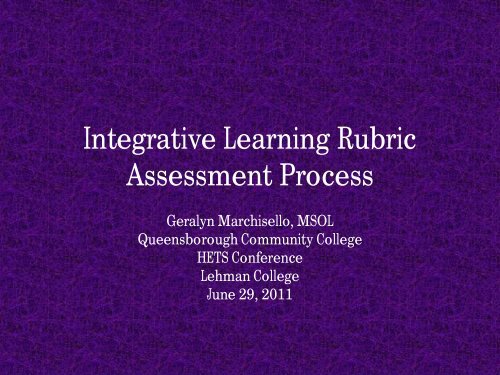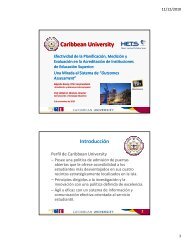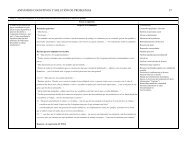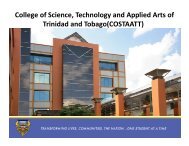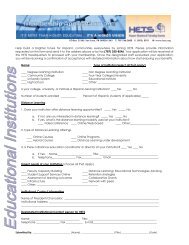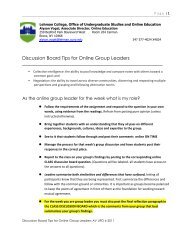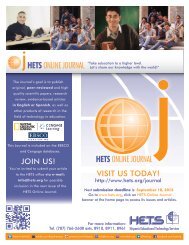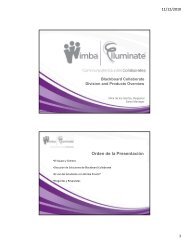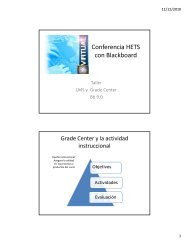Integrative Learning Rubric Assessment Process - HETS
Integrative Learning Rubric Assessment Process - HETS
Integrative Learning Rubric Assessment Process - HETS
You also want an ePaper? Increase the reach of your titles
YUMPU automatically turns print PDFs into web optimized ePapers that Google loves.
<strong>Integrative</strong> <strong>Learning</strong> <strong>Rubric</strong><br />
<strong>Assessment</strong> <strong>Process</strong><br />
Geralyn Marchisello, MSOL<br />
Queensborough Community College<br />
<strong>HETS</strong> Conference<br />
Lehman College<br />
June 29, 2011
“We are engaged in nothing less than an effort<br />
to change the focus of the national<br />
conversation from artificial, shorthand<br />
indicators of learning to something that<br />
reflects the shared work and understanding of<br />
faculty members and academic professionals<br />
across campuses” Terrel L. Rhodes, Director of the VALUE project and<br />
Vice President of the Association for<br />
American Colleges and Universities (AAC&U)
Queensborough Community College<br />
Named one of 12 Roadmap Enrollment to Engagement<br />
Colleges – AAC & U and MetLife<br />
AAC & U Project Leap VALUE <strong>Rubric</strong>s Pilot Participant<br />
LEAP project designed to assist community colleges in creating robust and<br />
proactive programs of academic support—tied to expected learning outcomes—<br />
that engage students at entrance and teach them how to become active partners<br />
in their own quest for educational success<br />
CAAL – sought and received funding to build, test, and release a centralized<br />
repository and a data collection/access protocol or standard for the repository<br />
QCC one of five campuses to pilot the norming and collection processes<br />
LEAP – Liberal Education and America’s Promise<br />
VALUE – Valid <strong>Assessment</strong> of <strong>Learning</strong> in undergraduate Education<br />
CAAL - Collaborative for Authentic <strong>Assessment</strong> and <strong>Learning</strong>
Intellectual and Practical Skills<br />
– Inquiry and analysis<br />
– Critical thinking<br />
– Creative thinking<br />
– Written communication<br />
– Oral communication<br />
– Reading<br />
– Quantitative literacy<br />
– Information literacy<br />
– Teamwork<br />
– Problem solving<br />
Personal and Social Responsibility<br />
– Civic engagement<br />
– Intercultural knowledge and competence<br />
– Ethical reasoning<br />
– Lifelong learning<br />
<strong>Integrative</strong> and Applied <strong>Learning</strong><br />
– <strong>Integrative</strong> learning<br />
VALUE RUBRICS
High Impact Practices of AAC&U<br />
<strong>Learning</strong> Communities<br />
Writing Intensive Classes<br />
Common Intellectual Experiences<br />
Project Based <strong>Learning</strong><br />
Global and Diversity <strong>Learning</strong><br />
Capstone Experiences<br />
Service <strong>Learning</strong>
High Impact Practices of QCC<br />
e-Portfolio<br />
Cornerstone<br />
<strong>Learning</strong> Communities<br />
Service <strong>Learning</strong><br />
Writing Intensive Courses
High Impact Educational Practices<br />
What they are, who has access to them and why do they<br />
matter? By George D. Kuh<br />
“The results of participating in these highimpact<br />
practices are especially striking for<br />
students who are further behind in terms of<br />
their entering academic test scores. The<br />
benefits are similarly positive for students<br />
from communities that historically have been<br />
underserved in higher education.”
Educational Objectives of the QCC<br />
Communicate effectively through reading, writing, listening<br />
and speaking<br />
Use analytical reasoning to identify issues or problems<br />
Use information management and technology skills effectively<br />
for academic research and life-long learning<br />
Integrate knowledge and skills in their program of study<br />
Differentiate and make informed decisions about issues based<br />
on multiple value systems<br />
Apply aesthetic and intellectual criteria in the evaluation or<br />
creation of works in the humanities or the arts
<strong>Integrative</strong> <strong>Learning</strong> (IL)VALUE Rubirc<br />
Definition<br />
An understanding and a disposition that a<br />
student builds across the curriculum and cocurriculum,<br />
from making simple connections<br />
among ideas and experiences to synthesizing<br />
and transferring learning to new, complex<br />
situations within and beyond the campus
Framing IL Language<br />
Creating the Frame for Teaching and <strong>Learning</strong><br />
<strong>Integrative</strong> assignments that serve to foster students’ abilities to integrate<br />
learning in this rapidly changing and increasingly connected world<br />
Developing increased integrative capacity is central to a students<br />
– Personal success<br />
– Social Responsibility<br />
– Civic Engagement<br />
<strong>Integrative</strong> learning is not a benefit – it is a necessity<br />
Its all about making connections - connecting and evolving a deeper<br />
understanding of theory and practice<br />
Extension of the integrative abilities to the challenges of personal,<br />
professional, and civic life<br />
Important to design structures, assignments, environments where<br />
exchange of experience and understanding is encouraged<br />
AAC&U
Glossary – terms and concepts for the IL rubric<br />
Academic learning: disciplinary learning; learning from academic study<br />
Content: The information conveyed in the work samples or collections of work<br />
Contexts: Actual or simulated situations in which a student demonstrates learning outcomes.<br />
New and challenging contexts encourage students to stretch beyond their current frames of<br />
reference<br />
Cocurriculum: A parallel component of the academic curriculum that is in addition to the<br />
formal classroom (student government, community service, residence hall activities, student<br />
organizations, etc)<br />
Experience: <strong>Learning</strong> that takes place in a setting outside of the formal classroom, such as a<br />
workplace, service learning site, internship etc.<br />
Form: The external frameworks within which information and evidence are presented,<br />
ranging from choices for a particular work sample or collection of works (such as research<br />
paper, PPT presentations, video recordings etc.) to choices in the makeup of the e-portfolio<br />
Performance: A dynamic and sustained act that brings together knowing and doing (creating<br />
a painting, solving an experimental design problem, developing a pr strategy for a business,<br />
etc.) performance makes learning observable<br />
Reflection: A metacognitive act of examining a performance in order to explore its<br />
significance and consequences<br />
Self-<strong>Assessment</strong>: Describing, interpreting and judging a performance based on stated or<br />
implied expectations followed by planning for further learning
Five IL <strong>Learning</strong> Outcomes<br />
Connects to Experience<br />
– Connects relevant experience and academic knowledge<br />
Connections to Discipline<br />
– Sees (makes) connections cross disciplines, perspectives<br />
Transfer<br />
– Adapts and applies skills, abilities, theories, or methodologies<br />
gained in one situation to new situation<br />
Integrated Communication<br />
Reflections and Self-<strong>Assessment</strong><br />
– Demonstrates a developing sense of self as a learner, building on prior experiences to<br />
respond to new and challenging contexts (may be evident in self-assessment, reflection,<br />
or creative work)
Level of performance<br />
Benchmark (1)<br />
Milestones (2)<br />
Milestones (3)<br />
Capstone (4)<br />
Please refer to the handout to appreciate the<br />
performance gradients
Understanding “performance”<br />
Levels do not represent year in school<br />
Nor do they correspond to to grades (A,B,C…)<br />
Capstone<br />
Milestones<br />
Benchmark<br />
– reflects the demonstration of achievement for the specific<br />
criterion for a student who graduates with a BA<br />
– Suggest key characteristics of progressive learning as through<br />
to graduation<br />
– The learning skills and abilities found among beginning<br />
students AAC&U
The process<br />
A call for faculty participant / student permission forms<br />
collected along with their work sample – anonymously<br />
numbered<br />
Inter-disciplinary work samples were collected for scoring<br />
(Honors, Chemistry and Math, Business courses, Art history,<br />
Basic Skills, Health Science and English)<br />
Three rounds of assessment (prompted and non-prompted<br />
samples)<br />
Every “scorer” received the rubric and work<br />
An overview presentation was conducted<br />
Some sample scoring took place – two people reading/scoring<br />
a piece
What happened<br />
A lively - enlightening discussion followed<br />
After a lunch break – a shift in the scoring took place<br />
An apparent evolvement of thought regarding assessment<br />
emerged<br />
A bit of time was needed for some instructors to shift from a<br />
“grading” to a “scoring” mindset<br />
Faculty began to interact and share ideas about development<br />
and expectations for both students and faculty<br />
We began to see the value of a shared common language with<br />
shared standards
What we found - Faculty<br />
“…The collegial experience of reflecting collaboratively was a welcomed<br />
relief from relief from the detail oriented tools that are often done<br />
independently”<br />
“…an extremely useful tool. It enables and encourages teachers to develop<br />
curriculum that will foster critical thinking skills that students will need in<br />
the future”<br />
“…with the use of this rubric, teachers can create assignments and<br />
assessments that will help students to connect their relevant experiences<br />
with the academic knowledge that they are learning”<br />
“…was a useful tool for understanding both the students writing and my<br />
own thinking process”<br />
“It was a true learning experience for me”<br />
“…Self-assessment and reflection is just as important for us as<br />
educators/instructors as it is for the students”<br />
“A two-way learning tool”
A note about the VALUE <strong>Rubric</strong>s<br />
Reflect the emphasis the academy places on the ability to<br />
analyze and integrate knowledge in a variety of ways<br />
<strong>Rubric</strong>s offer regular milestones by which students can gauge<br />
their own progress
“The sharing of rubrics, of expectations for<br />
learning, perhaps most importantly allows our<br />
students to have a much clearer picture of<br />
what their learning should look like”<br />
Terrel Rhodes, Director of the VALUE project and<br />
Vice President of the Association for<br />
American Colleges and Universities (AAC&U)
A thought<br />
“The distinction I am making among three different kinds of culture-<br />
post-figurative, in which both children learn primarily from their<br />
forebears,<br />
co-figurative, in which both children and adults learn from their peers and<br />
pre-figurative, in which adults also learn from their children<br />
-are a reflection of the period in which we live”<br />
Margaret Mead<br />
Culture and Commitment
For further information<br />
Geralyn Marchisello, MSOL<br />
Administration Building<br />
Rm 503<br />
Queensborough Community College<br />
222-05 56th Ave<br />
Bayside, NY 11364<br />
(718) 631 - 6344<br />
gmarchisello@qcc.cuny.edu<br />
www.qcc.cuny.edu
Suggested Reading<br />
Kuh, G. (2008). High Impact Practices: what are they<br />
and why do they matter? Washington, D.C. AAC & U<br />
Rhodes, T. (2010). Assessing Outcomes and<br />
Improving Achievenment: Tip and Tools for Using<br />
<strong>Rubric</strong>s. Washington, D.C. AAC&U


